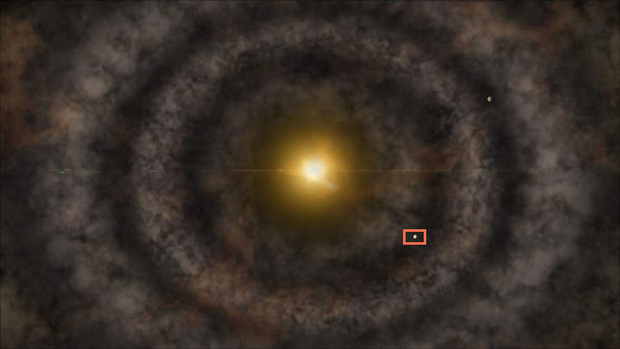Baby planets seen forming around a new star
It is an image that will overturn theories of how planets form and how common they are in the universe.
Scientists scanning a star nursery with a high resolution telescope found a new star with multiple concentric rings separated by clearly defined gaps. These gaps suggest that baby planets are orbiting the young sun, sweeping away and accumulating dust in their paths.
The system was imaged by the Atacama Large Millimeter/submillimeter Array (ALMA), a $1.3 billion radio telescope, in its new, high-resolution mode. The forming solar system, called HL Tau, is located about 450 light-years from Earth in the constellation Taurus.
"These features are almost certainly the result of young planet-like bodies that are being formed in the disk. This is surprising since HL Tau is no more than a million years old and such young stars are not expected to have large planetary bodies capable of producing the structures we see in this image," said ALMA Deputy Director Stuartt Corder in a statement.
Astronomers think stars form within clouds of hot gas and dust particles that collapse under gravity. Over time, the dust clumps into sand, pebbles, and larger-size rocks and form a thin planet-forming - or protoplanetary - disk where asteroids, comets, and planets originate. Once planetary bodies grow large enough, they create rings and gaps.
In a press conference held as a Google+ Hangout on Thursday, Corder said, "This level of resolution was completely impossible before." NL Tau had been seen before in lower resolution "as a blob of 2 to 3 pixels." The new ALMA image provides "in many pixels" the clearest picture to date of planet formation.
"This new and unexpected result provides an incredible view of the process of planet formation. Such clarity is essential to understand how our own Solar System came to be and how planets form throughout the Universe," said Tony Beasley, director of the National Radio Astronomy Observatory (NRAO) in Charlottesville, Virginia, in a press release.
HL Tau is "so young that it is invisible in optical light. Hubble cannot see it," according to NRAO astronomer Crystal Brogan.
In visible or infrared light the forming system is just a smear of dust and gas. But particles in the protoplanetary disk are heated up by the young sun, and give off X-rays. "This is truly one of the most remarkable images ever seen at these wavelengths," Brogan said. "The level of detail is so exquisite that it's even more impressive than many optical images. The fact that we can see planets being born will help us understand not only how planets form around other stars but also the origin of our own Solar System."
ALMA was able to see so much detail by spacing 30 of its antennas up to 15 kilometers apart. According to the scientists, the resolution is equivalent to imaging "a penny as seen from more than 110 kilometers away."
Scientists will look next at whether the chemical building blocks of life are present in the clouds of dust and gas.
Anthony Remijan, Assistant Scientist in charge of ALMA Commissioning and Science Verification for NRAO, said in the press conference, "There was a not a whole lot of time to form molecules" from the birth of our planet "to the beginning of the fossil record." Though the technology does not yet exist to do it, he is hoping that in a year or so ALMA can be used to identify gases and organic molecules in HL Tau or other baby planetary systems. "We need to understand the chemistry that forms prebiotic molecules. Chemistry is usually done in a bottle in a lab somewhere. We want to understand the chemistry going on in the universe."
Corder put it into perspective: "How do you get to the point where you have planets orbiting a mature star with water and molecular content that supports life? How did the rock we stand on get here? It's a fundamental 'how did we get here' question."
